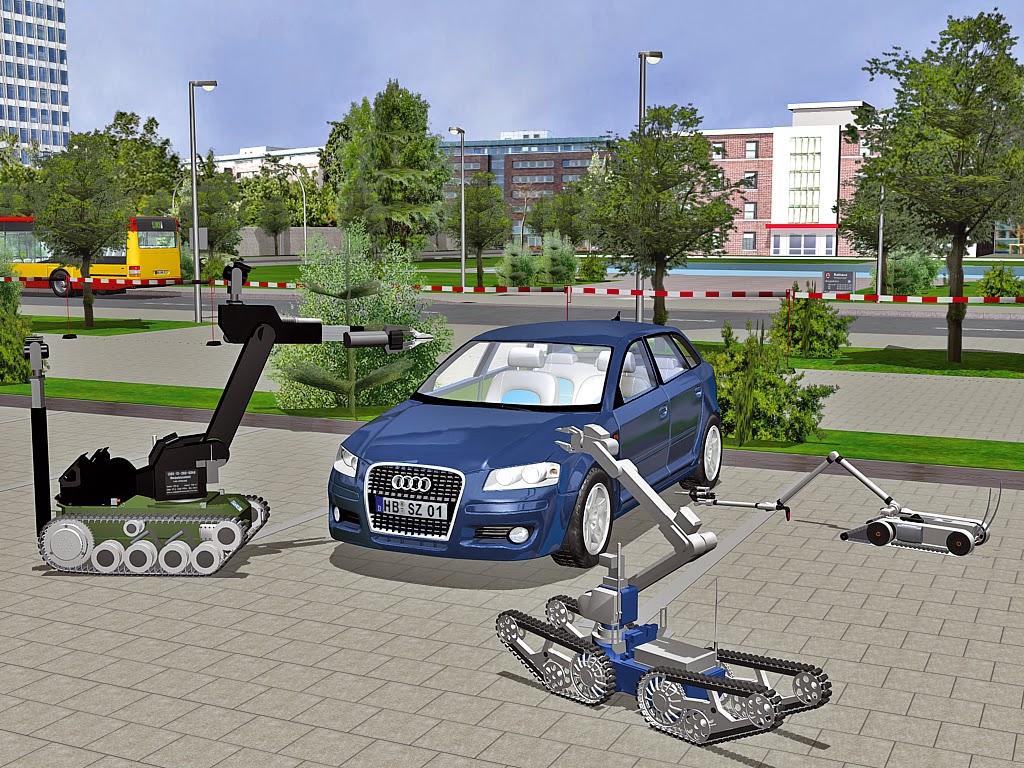The Bremen-based szenaris GmbH develops and produces learning programs and simulations for learning at the computer. In the recent past, particularly simulations have become more important for the training of operators of highly complex machinery such as robots or vehicles. A substantial factor for this development is the rapid technical progress. Another decisive reason for the increasing use of simulations is the fact that neither people nor equipment can be injured or damaged, because training in a simulation does not jeopardise humans, control elements or the equipment in use. In the event that a trainee makes a mistake, the simulation can simply be restarted. Another advantage is that environmental parameters can be changed in a simulation anytime. Moreover, many simulations support different levels of difficulty. And if this is not enough, a simulation can be extended by additional terrains, objects and / or scenarios. All this provides an ideal transition into reality for the trainee.
An example for this is the PC-based virtual reality simulation developed by szenaris for the training of operators of remotely controlled robotic vehicles. Such vehicles are used to explore and eliminate dangerous objects such as improvised explosive devices (IED). The vehicles must be operated without errors for a disposal to be carried out safely. In the simulation, the vehicles are integrated as 3D models designed in great detail in multiple virtual training environments, such as a car, bus, aircraft, building, terrain and many more. Sophisticated physics engines enable a realistic behaviour of the robotic vehicles. The vehicles are operated with the original control devices which are connected to a PC. The simulation comprises all vehicle functions such as driving, arm movements, the gripper function, camera and lighting as well as shooting with shotgun and disruptor. Currently, the simulation includes the tEODor, PackBot EOD and telemax vehicles. It can be extended by additional robotic vehicles on demand.
Another example for the use of simulations as training systems is the “Cooperative Computer Based Training (CoCBT) for the Foldable Longspan Bridge (FLB)”. In this virtual reality simulation, the collaboration for the operation of diverse pioneer bridge systems can be trained on networked workstations. The scalable technology enables integrating further trainee workstations or extending the view of the virtual world up to a 360° panoramic view. Furthermore, additional contents can be added to the system. Currently, trainings developed by szenaris for the bridge systems “Amphibian M3”, “Improved Ribbon Bridge (IRB)” and “Foldable Longspan Bridge (FLB)” are implemented on the platform.
These two examples show: Simulations are an ideal method to train the operation of complex robots, vehicles and other machinery in a safe environment to be optimally prepared for real missions.
 |
| Simulation for the operation of robotic vehicles |
An example for this is the PC-based virtual reality simulation developed by szenaris for the training of operators of remotely controlled robotic vehicles. Such vehicles are used to explore and eliminate dangerous objects such as improvised explosive devices (IED). The vehicles must be operated without errors for a disposal to be carried out safely. In the simulation, the vehicles are integrated as 3D models designed in great detail in multiple virtual training environments, such as a car, bus, aircraft, building, terrain and many more. Sophisticated physics engines enable a realistic behaviour of the robotic vehicles. The vehicles are operated with the original control devices which are connected to a PC. The simulation comprises all vehicle functions such as driving, arm movements, the gripper function, camera and lighting as well as shooting with shotgun and disruptor. Currently, the simulation includes the tEODor, PackBot EOD and telemax vehicles. It can be extended by additional robotic vehicles on demand.
| Virtual reality simulation for the operation of diverse pioneer bridge systems.. |
Another example for the use of simulations as training systems is the “Cooperative Computer Based Training (CoCBT) for the Foldable Longspan Bridge (FLB)”. In this virtual reality simulation, the collaboration for the operation of diverse pioneer bridge systems can be trained on networked workstations. The scalable technology enables integrating further trainee workstations or extending the view of the virtual world up to a 360° panoramic view. Furthermore, additional contents can be added to the system. Currently, trainings developed by szenaris for the bridge systems “Amphibian M3”, “Improved Ribbon Bridge (IRB)” and “Foldable Longspan Bridge (FLB)” are implemented on the platform.
These two examples show: Simulations are an ideal method to train the operation of complex robots, vehicles and other machinery in a safe environment to be optimally prepared for real missions.

Compared with other technologies, robotics is considered as a prestigious one among people. Robotics Training Chennai is one of the important training taken by the students mostly.
ReplyDelete